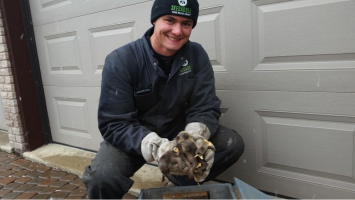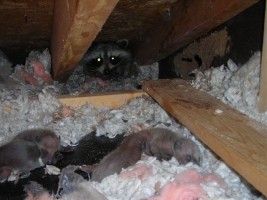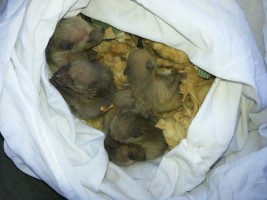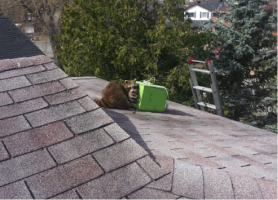
Baby season is here! Each spring Skedaddle Humane Wildlife Control receives hundreds of calls from home and business owners who have raccoons in their attics, chimney or crawlspaces. Mother raccoons begin to give birth in March and will continue to have babies through spring and early summer.
Raccoons do not construct their own den sites and would traditionally make their home inside natural tree and rock hollows. In urban areas, raccoons have discovered that attics, chimneys and sheds offer superior protection.
Why raccoons choose your home as a place to have their young:
Raccoons live in attics because it’s a great den site. Attics are generally warm, dry, safe and protected from the elements. Attics are often in close proximity to the food sources of urbanized animals – garbage cans, pet food, and other human-influenced food sources. An attic is like a big, hollow tree or cave – it’s a great place to live! Additionally, female animals have a strong denning instinct when they are pregnant, and instinctively seek out safe, enclosed areas. It’s very common for a female animal about to bear young to find its way into an attic.

Raccoons are excellent climbers, they are very strong, and they have very nimble hands. They have no problem entering any attic they choose, on almost any home. Most of the time, they’ve chosen an attic based on convenience or proximity to their normal home range.
How to know If your home if hosting a family of raccoons:
Most people become aware that an animal is living in their attic when they hear scampering, scratching, or walking noises above the ceiling.
Raccoons are the largest of these animals, so the sound is often “heavy” – more like thumping or walking than the light scurrying of a squirrel or mouse. In addition, raccoons are often vocal, and it’s possible to hear their various growls, chirps, cries, and other noises. If there’s a raccoon family, consisting of a female and a litter of baby raccoons, you will very often hear the very distinct and unique crying and whining of the babies, definite evidence of raccoon presence.
 Raccoon babies are born with their eyes closed and are capable of vocalizing almost immediately. By six weeks of age the babies will have begun to move and travel within the den site. During this time the noise and activity inside the attic usually becomes unbearable for most homeowners.
Raccoon babies are born with their eyes closed and are capable of vocalizing almost immediately. By six weeks of age the babies will have begun to move and travel within the den site. During this time the noise and activity inside the attic usually becomes unbearable for most homeowners.
Most baby animals found inside attics, under porches or down chimneys are not mobile for several weeks to months after birth. That means the only way to remove them humanely is by hand. This method is both effective and significantly reduces any chance of injuring them. Once the babies have been retrieved, they are placed inside a specially designed and heated reunion box with the insulation they’ve been living in.
This baby reunion box is designed so that it can be placed near the entry point so their mom can come back, and move them to one of her other known den sites in the neighborhood.
Mothers are highly protective of their young and should not be approached if a litter is suspected. Humane removal of a mother and her young is a must to ensure both her and her babies are safe and well-kept for.
The Removal Process
During the birthing season, Skedaddle Humane Wildlife Control begins each raccoon removal with a thorough search of your home for babies. Immobile raccoon babies cannot be trapped or chased from the attic. That means they must be located and removed from the attic by hand. This method is both effective and significantly reduces any chance of injuring them.
We know that mother raccoons will go to great lengths to protect and hide their babies. Finding them is almost never easy and almost always involves crawling through a cramped, sweltering attic full of itchy fiberglass insulation that’s full of raccoon urine and feces, something you want to leave to the professionals!
Once the babies have been retrieved, they are placed inside a specially designed and heated reunion box with the insulation they’ve been living in. This baby reunion box is designed so that it can be placed near the entry point so their mom come back and get them.

Raccoons, like many other species of wildlife, typically have numerous den sites throughout the neighborhood. When we’ve removed the babies and placed them in the baby box, mom must exit the den site in order to reunite herself with them. Our technicians will have prevented her from getting back inside so the mom is forced to relocate her babies one-by-one to one of her other den sites nearby. Relocating and separating a mom from her babies is not only unnecessary, it’s also ineffective and inhumane.
Now that Skedaddle Humane Wildlife Control has taken her from one of her den sites and sealed and protected it against her re-entry, she will have no choice but to just move on to another site — with babies in tow.
If you find yourself with a family of raccoons in the attic be sure to consider the complications that immobile babies can pose. When in doubt, call the professionals at Skedaddle Humane Wildlife Control.
Our trained specialists will perform a thorough inspection of your home to determine how the raccoons have found their way in. We then provide each of our customers with a written quote that outlines our findings as well as the exact solution we will implement to solve the problem and prevent it from happening again. We have been humanely removing animals and their babies from homes for over 27 years. Our experience and commitment to humane treatment of animals can’t be beat.
If you think you have a raccoon problem, call Skedaddle Humane Wildlife Control today. 1-888-592-0387.
Proudly serving: Ottawa, Montreal, Halifax, Hamilton, Burlington, Oakville, Mississauga, Brampton, Kitchener-Waterloo, Guelph, Sudbury, St. Catharines, Cambridge and the Niagara Region.
Watch: Mother raccoon relocated her babies


